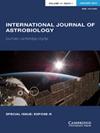Survival of Xanthoria parietina in simulated space conditions: vitality assessment and spectroscopic analysis
IF 1
4区 物理与天体物理
Q3 ASTRONOMY & ASTROPHYSICS
引用次数: 2
Abstract
Xanthoria parietina is a widespread foliose lichen growing on barks and rocks showing a broad spectrum of tolerance to air pollutants such as NOX and heavy metals, and resistance to UV-radiation because of the screening properties provided by the secondary metabolite parietin. The aim of this study was to evaluate the ability of this lichen species to survive in the following simulated space conditions, UV-radiation in N2 atmosphere and UV-radiation in vacuum. The efficiency of the photosynthetic apparatus was used as an indicator of vitality, and was expressed in terms of chlorophyll a fluorescence (FV/FM) and Normalized Difference Vegetation Index (NDVI), which were measured within 72 h from the exposure. Additionally, during the irradiation, the IR reflectance spectrum of the lichen was monitored in situ to assess changes in spectral bands. The results showed significant differences in physiological recovery trends between the treatments, highlighting that UV-radiation in vacuum causes stronger effects on FV/FM values. The IR analysis revealed several spectral band changes in the fingerprint region. The most visible variation was the 5200 cm−1 water band that disappeared in the overtone region. Nevertheless, X. parietina was able to survive UV-radiation in N2 atmosphere and in vacuum, and for this reason it may be considered a candidate for further evaluations on its survival capacity in extreme conditions.黄原菌在模拟空间条件下的存活:活力评估和光谱分析
parietina黄病菌(Xanthoria parietina)是一种生长在树皮和岩石上的广泛生长的毛叶苔藓,由于其次生代谢物parietin提供的筛选特性,对NOX和重金属等空气污染物具有广泛的耐受性,并对紫外线辐射具有抗性。本研究的目的是评估该地衣物种在模拟空间条件下的生存能力,即氮气大气和真空环境下的紫外线辐射。叶绿素a荧光(FV/FM)和归一化植被指数(NDVI)是在暴露后72 h内测量的,以光合机构的效率作为活力指标。此外,在辐照过程中,原位监测地衣的红外反射光谱,评估光谱波段的变化。结果表明,不同处理间的生理恢复趋势存在显著差异,表明真空紫外线辐射对FV/FM值的影响更大。红外光谱分析显示指纹区有多个光谱带变化。变化最明显的是5200 cm−1水带在泛音区消失。然而,X. parietina能够在N2大气和真空中存活紫外线辐射,因此它可以被认为是进一步评估其在极端条件下生存能力的候选者。
本文章由计算机程序翻译,如有差异,请以英文原文为准。
求助全文
约1分钟内获得全文
求助全文
来源期刊

International Journal of Astrobiology
地学天文-地球科学综合
CiteScore
3.70
自引率
11.80%
发文量
45
审稿时长
>12 weeks
期刊介绍:
International Journal of Astrobiology is the peer-reviewed forum for practitioners in this exciting interdisciplinary field. Coverage includes cosmic prebiotic chemistry, planetary evolution, the search for planetary systems and habitable zones, extremophile biology and experimental simulation of extraterrestrial environments, Mars as an abode of life, life detection in our solar system and beyond, the search for extraterrestrial intelligence, the history of the science of astrobiology, as well as societal and educational aspects of astrobiology. Occasionally an issue of the journal is devoted to the keynote plenary research papers from an international meeting. A notable feature of the journal is the global distribution of its authors.
 求助内容:
求助内容: 应助结果提醒方式:
应助结果提醒方式:


